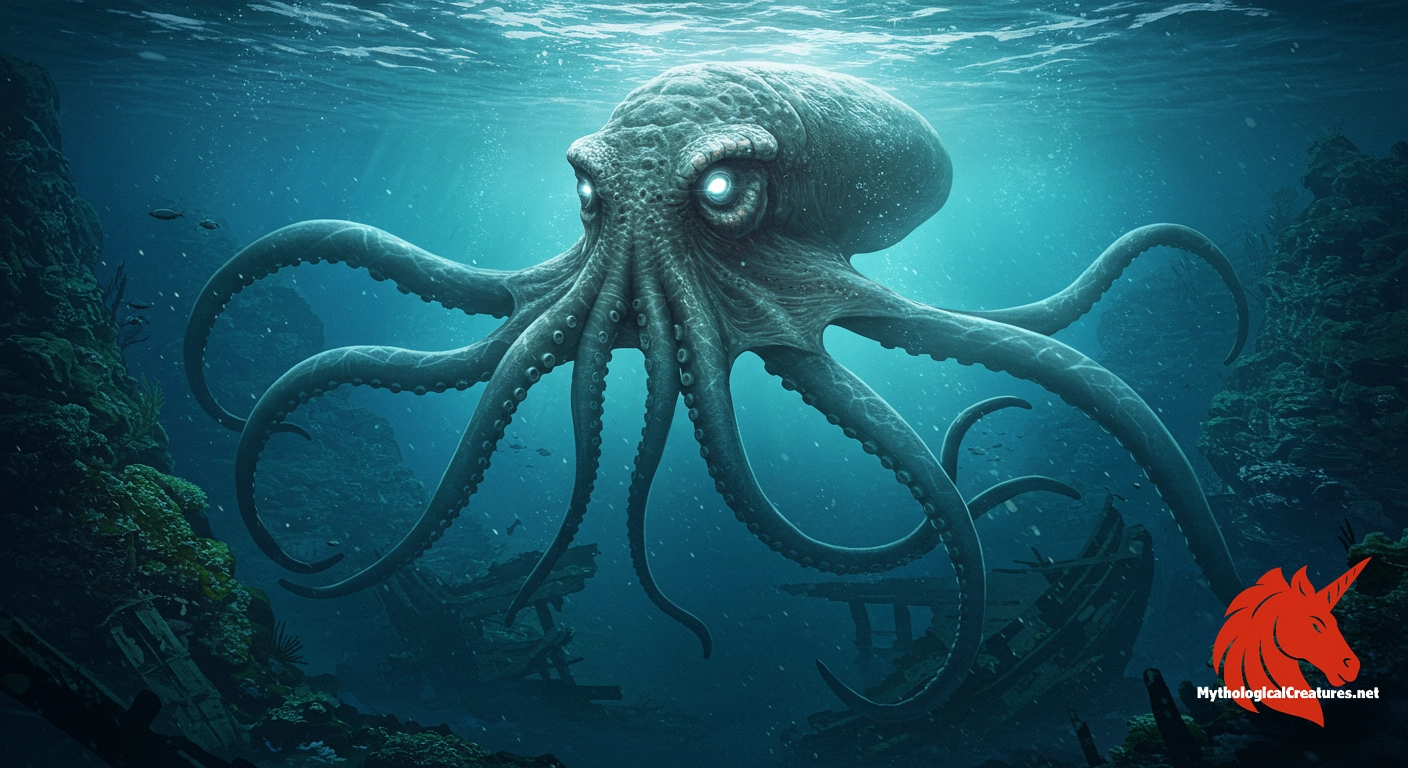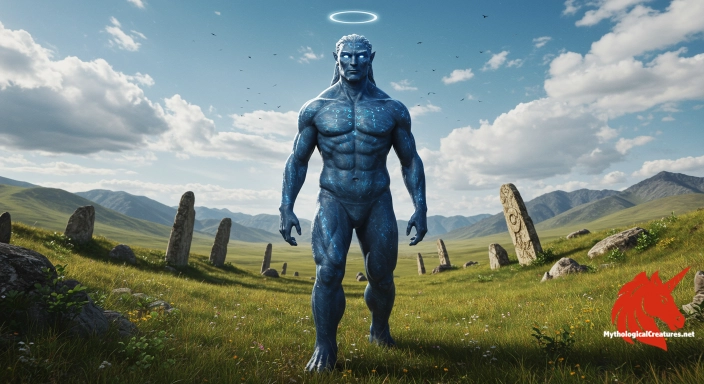Kraken: The Kraken is a legendary sea monster from Scandinavian folklore, renowned for its enormous size and terrifying presence in the deep ocean.

Kraken
Kraken - The Kraken symbolizes the mysterious and perilous nature of the deep sea, inspiring fear and fascination among seafarers.
Origins & First Encounters
The Kraken is a legendary sea monster that has fascinated seafarers for centuries with its immense size and mysterious origins. It is traditionally believed to inhabit the icy, turbulent waters between Norway and Iceland, where the restless ocean conceals secrets too vast for the human mind. Its modern emergence in written records dates back to the early 1700s, when travellers began to articulate their encounters with this enigmatic behemoth. Early depictions portrayed the creature as a cephalopod of colossal proportions, blurring the line between natural observation and supernatural lore. Maritime communities wove its image into their everyday narratives, imbuing the creature with both awe and dread. Stories of the Kraken have persisted over time, evolving through the retellings of sailors, explorers, and chroniclers alike. Its myth is an enduring fixture in the rich tapestry of northern maritime tradition, emblematic of the peril and mystery of the open sea. These accounts continue to fuel the legend, merging the thin line between myth and the unfathomable depths of the natural world. The Kraken remains a timeless symbol, reminding us of the ocean’s boundless power and the enduring allure of the unknown.
Source Texts & Tale Variants
The array of sources chronicling the Kraken spans travelogues, ecclesiastical writings, and imaginative literary works, each contributing vivid details to its legend. Early modern accounts, such as the travelogue by Francesco Negri from 1700, offered some of the first systematic descriptions of this enormous sea creature. Subsequent narratives, including those from Hans Egede in 1734, enriched the lore by linking the Kraken with older medieval tales like the hafgufa. The Danish bishop Pontoppidan, writing in 1753, was among the first to define the creature as a colossal octopus, imbuing his descriptions with an aura of terror through mentions of ships being dragged beneath the waves. Later studies by the French malacologist Denys-Montfort in the nineteenth century hinted at the natural basis of these legends by exploring the existence of gigantic cephalopods. French literary giants such as Victor Hugo and Jules Verne reimagined the Kraken in their works, blending folklore with creative embellishment. These varied accounts illustrate how personal observation, myth, and literary invention have intermixed over the centuries. Indirect references from naturalists like Linnaeus and mentions in writings on medieval sea monsters further complicate the narrative. Collectively, this diverse collection of sources has ensured that the Kraken’s legend endures as a multifaceted and deeply embedded element of maritime myth.
Form & Powers
The Kraken is depicted as a massive cephalopod whose sheer physical presence defies the natural order of the seas. Its body is frequently imagined as shrouded in dark, briny hues that mirror the depths of the stormy ocean. Numerous arms or tentacles, each imbued with an almost supernatural strength, are said to extend far enough to ensnare entire vessels and their crews. Varying descriptions between different accounts sometimes attribute to it the qualities of a giant squid or octopus, underscoring a fluidity in its portrayal. The eyes of this creature are often rendered as deep and uncanny, reflecting the profound abyss that hides its secrets. Detailed illustrations and vivid storytelling detail textures of rippling skin and sinewy appendages that seem to pulse with a life of their own. The creature’s formidable beak and specially adapted suckers emphasize its predatory nature and its capacity to wreak havoc upon ships. Maritime travellers infused their encounters with personal dread through accounts that speak of monstrous, undulating limbs in a perpetual struggle against both nature and man. The physical form of the Kraken, while varying from account to account, consistently projects an image of overwhelming, almost mythic force that both mesmerises and terrifies.
Regional Faces
Regional interpretations of the Kraken reveal a kaleidoscope of perspectives shaped by local seafaring traditions and environmental conditions. In Scandinavian folklore, particularly among communities along the coasts of Norway and Iceland, the creature is depicted as an omnipresent force, emerging from dark, frigid waters to embody the ocean’s untamed spirit. Local narratives often intertwine the Kraken with other legendary creatures, such as the hafgufa, thereby reinforcing its status as an essential part of maritime myth. Coastal cultures have long seen the Kraken as not merely a source of terror but also as a mysterious guardian of the deep, whose appearance portends both doom and renewal. Variations in its description across regions reflect differences in coastal geography and the unique challenges of life at sea. In some renditions, the Kraken is endowed with supernatural features—a pair of glowing eyes or an almost imperceptible aura—that accentuate its otherworldly presence. The impact of local climate, sea conditions, and historical sea routes has all contributed to the evolution of its character in regional lore. These diverse regional accounts illustrate how the Kraken has been adapted to reflect local fears, beliefs, and the inherent majesty of the natural world. Ultimately, the regional diversity in its portrayal adds layers of complexity to an already multifaceted legend.
Cultural Parallels
The tale of the Kraken finds intriguing parallels in mythologies across the globe, where monstrous sea entities serve as symbols of the mysterious and uncontrollable ocean. Echoing the terrifying sea serpents of Greek lore and the enigmatic umibozu from Japanese legend, the Kraken stands as a universal embodiment of maritime peril. The creature shares common ground with reports of giant squids and other enormous cephalopods that have inspired both scientific inquiry and fantastical storytelling. Despite differences in cultural aesthetics and environmental context, these creatures all function as metaphors for nature’s enormity and its ability to defy human control. Some comparisons even extend to more modern iterations found in horror literature and cinema, where ancient maritime legends are reinterpreted to evoke primal fears. The shared themes across these disparate myths underline a collective human fascination with the unknown and a deep-seated respect for the forces of nature. While the Kraken’s tentacled form distinguishes it, the common threads of mystery, power, and existential dread interlace its narrative with other seaborne legends. This comparative landscape deepens our understanding of marine mythologies and highlights how different cultures channel their encounters with the profound vastness of the sea. In the end, the Kraken’s enduring appeal is not isolated but part of a universal story about the beauty and terror of the natural world.
Legacy & Modern Evolution
The evolution of the Kraken’s legend offers a compelling chronicle that spans centuries, transforming it from a sailor’s whispered anxieties into a celebrated cultural icon. Once feared for its purported ability to drag entire ships underwater, the Kraken has emerged as a potent symbol of the untamed, mysterious forces lurking beneath the ocean’s surface. Its depictions have evolved alongside advancements in marine science and artistic expression, shifting from crude descriptions in early travellers’ accounts to rich, layered portrayals in modern literature and film. Contemporary adaptations have reimagined the Kraken with a blend of historical myth and speculative science, often presenting it in forms that range from a gigantic cephalopod to fantastical, almost extraterrestrial entities. This evolution mirrors society’s ongoing fascination with the unknown, as well as our enduring struggle to reconcile natural phenomena with myth. Modern narratives in books, films, and video games have revitalised its image, continually reinforcing its status as the archetypal sea monster. This continual reinvention underscores a cultural legacy that bridges the maritime traditions of old with today’s vibrant pop culture. The Kraken’s journey from the shadowy depths of ancient lore to the spotlight of modern imagination reflects a broader narrative about the enduring power of myth. Ultimately, its legacy persists as both a warning and a celebration of the awe-inspiring mystery that lies beneath the surface of our world.
Interesting Fact
One interesting observation is that the legend of the Kraken may have been inspired by real-life encounters with giant squids, bridging the gap between myth and biological reality.
Quick Creature Info
Origin:
Features:
Associations:
Our Mythic Legendary Rating:

Also Sometimes Known As:
Habitat:
Supernatural Powers:
Physical Attributes:
Abilities:
Behavior:
Lore:
Related Creatures, Tales or Lore
- LLeviathan
- HHafgufa
- GGiant Squid
References
Discover Another Mythical Legend You May Not Have Heard Of?
Uncover the mysteries of ancient folklore and expand your knowledge of legendary beings from cultures around the world.
Dare to Meet the Tengri....
Mythical Disclaimer: The images and data on this site are derived from various historical and literary sources, but we have found that many myths often have multiple versions and interpretations across references, sometimes contradictory. As a result, these creature depictions are artistic interpretations—imaginative blends of folklore, legend, and a dash of AI guesswork. Because creature descriptions vary widely, our illustrations and accompanying information represent our best effort to honor mythology while bridging creative gaps. Enjoy these interpretations—just remember, we've done our best to respect the stories and validate available data, but in the realm of mythology, details often shift, imagination leads the way, and nothing is ever set in stone!
Curated by the Mythological Creatures Team (rev. May 2025)
